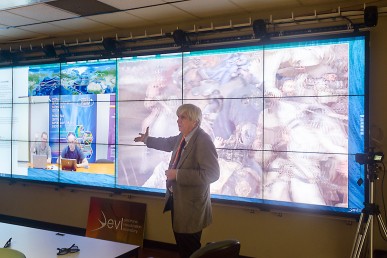Ultra-hi-def 3-D movies stream from Poland to UIC
Ultra-high definition “4K” 3-D digital movies—with more than four times higher resolution than HDTV—were streamed on high performance optical cables from Poland to the University of Illinois at Chicago’s Electronic Visualization Laboratory as part of the first annual US Ignite Application Summit.
US Ignite tries to spark the development of new computing applications that will impact on how we live and work.
“Distribution of ultra-high-resolution 2-D, and eventually 3-D, movies to research labs, classrooms, offices, and homes in the future will rely on advanced software, not expensive hardware and high-speed optical networks,” said Maxine Brown, associate director of the EVL.
A 3-D movie is actually two movies—one for each eye. Theaters use two different polarizing lenses on two projectors to project the overlapping images onto the screen.
But EVL’s high-tech classroom does not have projectors, but a tiled display wall. Streaming the images required that the rows of each frame of the two movies be staggered with alternating rows displaying left- and right-eye images. Viewers still wear the familiar 3-D glasses worn at theaters.
The ability to stream digital media over high-performance networks is still developing. Special events, such as conferences, serve as motivation to push the envelope, Brown said.
The fiber link connecting Poland’s Poznan Supercomputing and Networking Center and the EVL was more than 6,000 miles long. Data flowed from Poznan over Poland’s PIONIER network; to NetherLight, a major network exchange in Amsterdam; then over ACE, the National Science Foundation-funded transatlantic network America Connects to Europe; to StarLight, a major network exchange in Chicago; and finally to EVL over UIC ‘s own fiber.
Developing next-generation internet applications for public benefit is one of the goals of US Ignite. The three 3-D films chosen for the presentation were about Poland’s history and culture: an animated “History of Poland” and a computer-graphic recreation of “Jan Matejko’s ‘The Battle of Grunwald'” painting—both created by Platige Image Studio—and a movie of modern-day Poznan created by its supercomputing and networking center.
In addition to the EVL and Poland’s Poznan Supercomputing and Networking Center, the presentation tapped into computer science expertise from the Czech Republic’s National Research and Education Network and the Institute of Computer Science at Masaryk University; Northwestern University’s International Center for Advanced Internet Research; and a global consortium of network owners and providers known as the Global Lambda Integrated Facility.
Additional staff in Poland, Amsterdam and Chicago provided networking and technical support.
“As technologies involved in this presentation and tiled display walls mature,” Brown said, “ultra-high-resolution information for teaching, remote collaboration, telemedicine, museums, the arts and entertainment will be more broadly shared.”
Categories
Topics
3-D, computing, data streaming, EVL, high speed networks, imaging, software, technology

